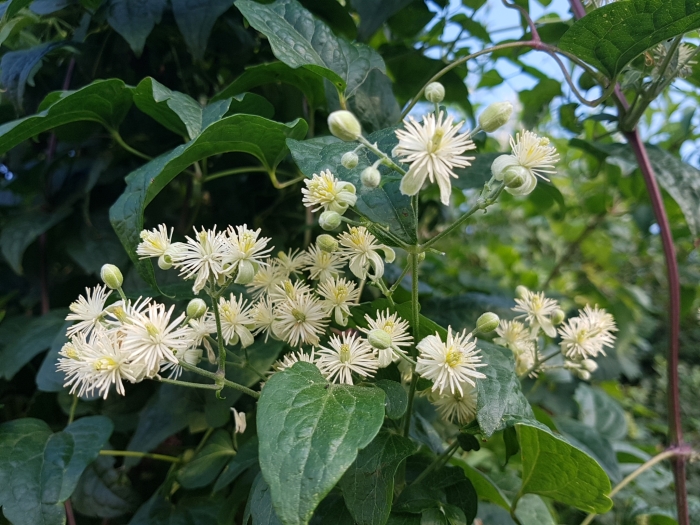Old Man’s Beard
(Clematis vitalba)
Old Man’s Beard (Clematis vitalba)
/
/

ahabo
CC BY 4.0
Image By:
ahabo
Recorded By:
Copyright:
CC BY 4.0
Copyright Notice:
Photo by: ahabo | License Type: CC BY 4.0 | License URL: http://creativecommons.org/licenses/by/4.0/ | Rights Holder: ahabo | Publisher: iNaturalist | Date Created: 2022-08-17T18:31:43-07:00 |




















Estimated Native Range
Summary
Clematis vitalba, commonly known as Old Man’s Beard or Traveller’s Joy, is a deciduous climbing shrub native to a variety of habitats including chalky slopes, hedgerows, and woodlands across Eurasia and North Africa. It is particularly associated with limestone-rich areas. This vigorous climber can reach lengths of up to 98 feet (30 meters), using its leaf stalks to twine around other plants and structures for support. Its appearance is characterized by its pinnate leaves and clusters of small, creamy-white, fragrant flowers that bloom from July to September, followed by distinctive, fluffy seed heads that resemble an old man’s beard.
Clematis vitalba is valued for its ability to cover unsightly structures quickly and its profuse flowering, which provides a long season of interest. It is often used to cover pergolas, fences, and walls. However, due to its rapid growth and ability to smother other plants, it requires careful management and regular pruning to keep it under control. It thrives in full sun to part shade and prefers well-drained, alkaline soils. While it is drought-tolerant once established, it benefits from regular watering during prolonged dry periods. Gardeners should be aware that Clematis vitalba is potentially invasive outside its native range and can outcompete native vegetation, so it is crucial to check local regulations before planting.CC BY-SA 4.0
Clematis vitalba is valued for its ability to cover unsightly structures quickly and its profuse flowering, which provides a long season of interest. It is often used to cover pergolas, fences, and walls. However, due to its rapid growth and ability to smother other plants, it requires careful management and regular pruning to keep it under control. It thrives in full sun to part shade and prefers well-drained, alkaline soils. While it is drought-tolerant once established, it benefits from regular watering during prolonged dry periods. Gardeners should be aware that Clematis vitalba is potentially invasive outside its native range and can outcompete native vegetation, so it is crucial to check local regulations before planting.CC BY-SA 4.0
Plant Description
- Plant Type: Herb, Vine
- Height: 1-30 feet
- Width: 1-30 feet
- Growth Rate: Rapid
- Flower Color: White
- Flowering Season: Summer
- Leaf Retention: Deciduous
Growth Requirements
- Sun: Full Sun, Part Shade
- Water: Low, Medium
- Drainage: Fast, Medium
Common Uses
Border Plant, Showy Flowers
Natural Habitat
Chalky slopes, hedgerows, and woodlands, particularly in limestone-rich areas
Other Names
Common Names: Old Man’s Beard, Wild Clematis, Gewoehnliche Waldrebe, Traveller’s Joy
Scientific Names: , Clematis vitalba, Anemone vitalba, Anemone vitalba, Clematis bannatica, Clematis bellojocensis, Clematis crenata, Clematis dumosa, Clematis dumosa, Clematis grata
GBIF Accepted Name: